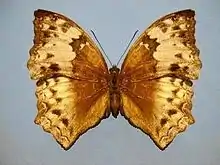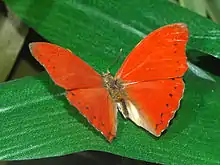Cymothoe
Cymothoe est un genre de lépidoptères (papillons) de la famille des Nymphalidae, de la sous-famille des Limenitidinae et de la tribu des Limenitidini[1].
Pour les articles homonymes, voir Cymothoe (homonymie).
Description
Les espèces de ce genre présentent un dimorphisme sexuel très marqué.
Répartition
Ce genre se rencontre en Afrique centrale.
Systématique
Le genre Cymothoe a été décrit par l'entomologiste allemand Jakob Hübner en 1819[2]. L'espèce type est Cymothoe althea (Cramer, 1776).
Taxinomie
_underside_2.jpg.webp)
Femelle Cymothoe egesta egesta, dans le parc national de Kakum au Ghana. Novembre 2021.
Liste alphabétique par groupe[1] :
- Le groupe de l'oemilius
- Cymothoe oemilius (Doumet, 1859)
- Le groupe de lhyarbita
- Cymothoe hyarbita (Hewitson, [1866])
- Cymothoe reinholdi (Plötz, 1880)
- Le groupe du lucasi
- Cymothoe lucasii (Doumet, 1859)
- Cymothoe megaesta Staudinger, 1889
- Cymothoe owassae Schultze, 1916
- Groupe non déterminé
- Cymothoe orphnina Karsch, 1894
 Cymothoe orphnina
Cymothoe orphnina
- Le groupe du lurida
- Cymothoe colmanti Aurivillius, 1898
- Cymothoe hypatha (Hewitson, 1866)
- Cymothoe lurida (Butler, 1871)
- Groupe non déterminé
- Cymothoe cyclades (Ward, 1871)
- Cymothoe fontainei Overlaet, 1952
- Cymothoe heliada (Hewitson, 1874)
- Cymothoe herminia Grose-Smith, 1887
- Cymothoe hesiodina Schultze, 1908
- Cymothoe hesiodotus Staudinger, 1889
- Cymothoe howarthi Rydon, 1981
- Cymothoe isiro Rydon, 1981
- Cymothoe ochreata Grose-Smith, 1890
- Cymothoe sassiana Schouteden, 1912
- Cymothoe weymeri Suffert, 1904
- Le groupe du fumana
_female.jpg.webp)
Femelle de Cymothoe fumana fumana, dans le parc national de Kakum, au Ghana.
- Cymothoe fumana (Westwood, 1850)
- Cymothoe haynae Dewitz, 1886
- Groupe non déterminé
- Cymothoe althea (Cramer, [1776])
- Cymothoe amenides (Hewitson, 1874)
- Cymothoe capella (Ward, 1871)
- Cymothoe caprina Aurivillius, 1897
- Cymothoe consanguis Aurivillius, 1896
- Cymothoe coranus (Grose-Smith, 1889)
- Cymothoe eris Aurivillius, 1896
- Le groupe du caenis
- Cymothoe alcimeda (Godart, [1824])
- Cymothoe alticola Libert & Collins, 1997
- Cymothoe caenis (Drury, [1773])
- Cymothoe jodutta (Westwood, 1850)
- Cymothoe teita van Someren, 1939
- Groupe non déterminé
- Cymothoe adela Staudinger, 1889
- Cymothoe altisidora (Hewitson, 1869)
- Cymothoe amaniensis Rydon, 1980
- Cymothoe angulifascia Aurivillius, 1897
- Cymothoe aubergeri Plantrou, 1977
- Cymothoe aurivillii Staudinger, 1899
- Cymothoe beckeri (Herrich-Schäffer, [1853])
- Cymothoe collarti Overlaet, 1942
- Cymothoe collinsi Rydon, 1980
- Cymothoe cottrelli Rydon, 1980
- Cymothoe dujardini Viette, 1971
- Cymothoe indamora Hewitson, 1866
- Cymothoe lambertoni Oberthür, 1923
- Cymothoe magambae Rydon, 1980
- Cymothoe melanjae Bethune-Baker, 1926
- Cymothoe vumbui Bethune-Baker, 1926
- Cymothoe zenkeri Richelmann, 1913
- Cymothoe zombana Bethune-Baker, 1926
- Le groupe du sangaris
- Cymothoe anitorgis (Hewitson, 1874)
- Cymothoe aramis (Hewitson, 1865)
 Cymothoe aramis
Cymothoe aramis - Cymothoe coccinata (Hewitson, 1874)
- Cymothoe euthalioides Kirby, 1889
- Cymothoe harmilla (Hewitson, 1874)
- Cymothoe hobarti Butler, 1900
 Cymothoe hobarti
Cymothoe hobarti - Cymothoe magnus Joicey & Talbot, 1928
- Cymothoe ogova (Plötz, 1880)
- Cymothoe sangaris (Godart, 1824)
- Groupe non déterminé
- Cymothoe arcuata Overlaet, 1945
- Cymothoe crocea Schultze, 1917
- Cymothoe distincta Overlaet, 1944
- Cymothoe excelsa Neustetter, 1912
- Cymothoe haimodia (Grose-Smith, 1887)
- Cymothoe hartigi Belcastro, 1990
- Cymothoe mabillei Overlaet, 1944
- Cymothoe meridionalis Overlaet, 1944
- Cymothoe preussi Staudinger, 1889
- Cymothoe radialis Gaede, 1916
- Cymothoe rebeli Neustetter, 1912
- Cymothoe reginaeelisabethae Holland, 1920
Notes et références
- Markku Savela, « Cymothoe genus », funet.fi, (consulté le )
- Hübner, [1819]; Verz. bek. Schmett. (3): 39
- Doubleday, [1848]; Gen. diurn. Lep. (1): pl. 41, f. 1
- Westwood, [1850]; Gen. diurn. Lep. (2): 287
- Distant, [1880]; Proc. zool. Soc. Lond. 1879 (4) : 704
Voir aussi
Liens externes
- (en) Référence NCBI : Cymothoe (taxons inclus)
- (en) Référence BioLib : Cymothoe Hübner, 1819
- (fr+en) Référence EOL : Cymothoe
- Portail de l’entomologie
Cet article est issu de Wikipedia. Le texte est sous licence Creative Commons - Attribution - Partage dans les Mêmes. Des conditions supplémentaires peuvent s'appliquer aux fichiers multimédias.

